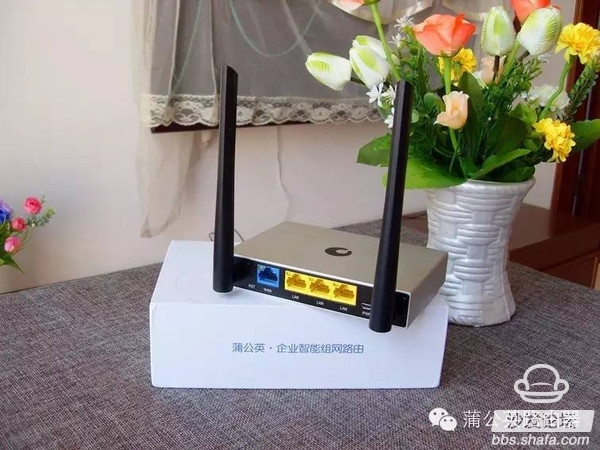In the era of smart products, smart new products emerge in various fields. From smart phones to smart TVs, and from daily work to daily life, smart products are increasingly permeating all aspects of our lives. As a home network terminal, the router is involved in the smart domain earlier. At present, the more popular smart routers are millet routers, polar routes, and Lenovo's Newifi new routes. Today's assessment for everyone is to do a domain name analysis peanut shell launched off-site VPC intelligent networking router products, the official name it "dandelion router."
Unpacking and Appearance Dandelion routers come in white paper boxes and the overall design is simple. The front is a simple pattern. This pattern is very interesting and seems to be passing through time and space. Yes, this router is playing through, play is the VPN remote intelligent network. The side of the box is the product name description. At the bottom is the introduction of product features: "Smart networking," "embedded peanut shells," and "cloud management platform."



The interior of the box adopts a layered design, which makes perfect use of the space inside the box. The upper part is the main product, and the lower part is the accessories of the power adapter and USB cable.



Different from general routers, the dandelion router shell material is very solid, the shell is an aluminum alloy shell after anodized aluminum painting process, the overall feel is very good. In addition, the overall router is also very small and exquisite, size is 128mm X 88mm. However, although the material is solid, but the appearance is not surprising, and 360 routers and millet routers compared to this router can be in the design and make certain improvements.

The dandelion router uses two external 5dBi high-gain omnidirectional antennas. Although it can't be removed, it can rotate 180 degrees and is suitable for placement in various positions and angles. In addition, 5dBi high-gain omnidirectional antenna can cover wireless wifi signals in a larger range.

Like the general router, the main interface is placed between two antennas. From left to right are the reset button, a 100M WAN interface, three 100M LAN ports, and a MicroUSB power input interface. The WAN port and the LAN port have different colors. At a glance, even non-professionals can clearly know how to set it up. It is worthy of praise that this router uses a small USB interface, 5V 1A power input, just find a mobile power can be used.


Background Management Open the browser and enter "oraybox.com" to enter the background of the router. For the first login, you need to enter the SN code of the laser on the back of the router and the mobile phone verification code to register.

Once verified, the user can enter the background to perform operations. The entire background is divided into three modules: "Homepage," "Device Management," and "Application Center." The hierarchy is quite clear and user-friendly. The "home page" mainly shows some information of the user's router, such as: public network IP, LAN IP, memory, hard disk occupation and other information.

In the "Management Devices" module, we can further detail the routers, similar to the "Advanced Management" module in ordinary routers. In this interface, we can set "DMZ", "UPNP", change LAN IP address and other operations on the router. Particularly worthy of praise is that compared with the ordinary route multi-level menu settings, this interface uses a menu setting, avoiding a lot of trouble for the user.

In the "Application Center" module, the official provides two special services: "Peanut shell dynamic domain name resolution" and "Sunflower remote boot." However, the "Sunflower Remote Startup" service is not yet open to users. The so-called "peanut shell dynamic domain name resolution", simply speaking, the peanut shell server will obtain your computer's current dynamic ip, and then constantly use the peanut shell domain binding your computer's current ip, so that others can access your peanut shell domain name can No need to care about your computer's ever-changing public network ip.

Analysis of product selling point The biggest selling point of this route is to use multiple dandelion routes to achieve remote VPC intelligent networking. With VPC technology, you can easily create a remote LAN connection in one minute without the need for public IP. Which can be applied specifically to those areas? Take a look at Peanut Shell's official website:

How to implement it? The author summarizes, probably needs the following several steps (ps: Because completes the intelligent network to need more than two dandelion routes, so the author found the same as this trial "Nan Nan Alisa" children's shoes. Thanks in this!)
Enter the background of the router, find the "Intelligent Networking" under the "Device Management" module, click to enter, the system will guide us to register a "peanut shell" account.

The next step is to add a route to this registered peanut shell account. After adding it, be sure to remember to drag it into the "selected network member" to complete the networking.

After the networking is complete, you can ping the IP address of the other party and verify whether it is successful. The specific approach is: Open the computer "Run" → enter "cmd" → enter "ping ip address".

If the ping is successful, the networking is successful. In the premise of successful networking, we can enter each other's routing to see the other party's routing information, and even help each other to set up routing. After successful networking, all members of the LAN can transfer files and share data with each other.
Written in the end compared to the previous tedious off-site networking, dandelion routing intelligent networking is much simpler. If only from the system level, this "dandelion routing" launched by Peanut Shell will undoubtedly be a success, and it will enable peanut shells from pure software suppliers to network equipment hardware manufacturing, software system services and integrated solution providers. change. Users only need to purchase the peanut shell hardware and enjoy the integrated solutions and services brought by the peanut shell. Of course, it is still not perfect, for example, 100M LAN port can be upgraded to Gigabit, so as to meet the enterprise-level big data sharing and transmission; can add a USB port to achieve routing capabilities.
Unpacking and Appearance Dandelion routers come in white paper boxes and the overall design is simple. The front is a simple pattern. This pattern is very interesting and seems to be passing through time and space. Yes, this router is playing through, play is the VPN remote intelligent network. The side of the box is the product name description. At the bottom is the introduction of product features: "Smart networking," "embedded peanut shells," and "cloud management platform."



The interior of the box adopts a layered design, which makes perfect use of the space inside the box. The upper part is the main product, and the lower part is the accessories of the power adapter and USB cable.



Different from general routers, the dandelion router shell material is very solid, the shell is an aluminum alloy shell after anodized aluminum painting process, the overall feel is very good. In addition, the overall router is also very small and exquisite, size is 128mm X 88mm. However, although the material is solid, but the appearance is not surprising, and 360 routers and millet routers compared to this router can be in the design and make certain improvements.

The dandelion router uses two external 5dBi high-gain omnidirectional antennas. Although it can't be removed, it can rotate 180 degrees and is suitable for placement in various positions and angles. In addition, 5dBi high-gain omnidirectional antenna can cover wireless wifi signals in a larger range.

Like the general router, the main interface is placed between two antennas. From left to right are the reset button, a 100M WAN interface, three 100M LAN ports, and a MicroUSB power input interface. The WAN port and the LAN port have different colors. At a glance, even non-professionals can clearly know how to set it up. It is worthy of praise that this router uses a small USB interface, 5V 1A power input, just find a mobile power can be used.


Background Management Open the browser and enter "oraybox.com" to enter the background of the router. For the first login, you need to enter the SN code of the laser on the back of the router and the mobile phone verification code to register.

Once verified, the user can enter the background to perform operations. The entire background is divided into three modules: "Homepage," "Device Management," and "Application Center." The hierarchy is quite clear and user-friendly. The "home page" mainly shows some information of the user's router, such as: public network IP, LAN IP, memory, hard disk occupation and other information.

In the "Management Devices" module, we can further detail the routers, similar to the "Advanced Management" module in ordinary routers. In this interface, we can set "DMZ", "UPNP", change LAN IP address and other operations on the router. Particularly worthy of praise is that compared with the ordinary route multi-level menu settings, this interface uses a menu setting, avoiding a lot of trouble for the user.

In the "Application Center" module, the official provides two special services: "Peanut shell dynamic domain name resolution" and "Sunflower remote boot." However, the "Sunflower Remote Startup" service is not yet open to users. The so-called "peanut shell dynamic domain name resolution", simply speaking, the peanut shell server will obtain your computer's current dynamic ip, and then constantly use the peanut shell domain binding your computer's current ip, so that others can access your peanut shell domain name can No need to care about your computer's ever-changing public network ip.

Analysis of product selling point The biggest selling point of this route is to use multiple dandelion routes to achieve remote VPC intelligent networking. With VPC technology, you can easily create a remote LAN connection in one minute without the need for public IP. Which can be applied specifically to those areas? Take a look at Peanut Shell's official website:

How to implement it? The author summarizes, probably needs the following several steps (ps: Because completes the intelligent network to need more than two dandelion routes, so the author found the same as this trial "Nan Nan Alisa" children's shoes. Thanks in this!)
Enter the background of the router, find the "Intelligent Networking" under the "Device Management" module, click to enter, the system will guide us to register a "peanut shell" account.

The next step is to add a route to this registered peanut shell account. After adding it, be sure to remember to drag it into the "selected network member" to complete the networking.

After the networking is complete, you can ping the IP address of the other party and verify whether it is successful. The specific approach is: Open the computer "Run" → enter "cmd" → enter "ping ip address".

If the ping is successful, the networking is successful. In the premise of successful networking, we can enter each other's routing to see the other party's routing information, and even help each other to set up routing. After successful networking, all members of the LAN can transfer files and share data with each other.
Written in the end compared to the previous tedious off-site networking, dandelion routing intelligent networking is much simpler. If only from the system level, this "dandelion routing" launched by Peanut Shell will undoubtedly be a success, and it will enable peanut shells from pure software suppliers to network equipment hardware manufacturing, software system services and integrated solution providers. change. Users only need to purchase the peanut shell hardware and enjoy the integrated solutions and services brought by the peanut shell. Of course, it is still not perfect, for example, 100M LAN port can be upgraded to Gigabit, so as to meet the enterprise-level big data sharing and transmission; can add a USB port to achieve routing capabilities.
![<?echo $_SERVER['SERVER_NAME'];?>](/template/twentyseventeen/skin/images/header.jpg)